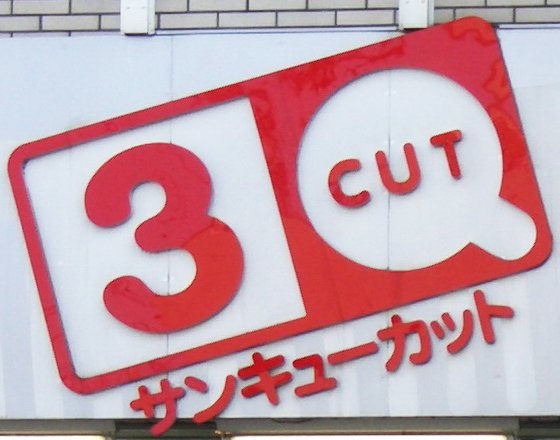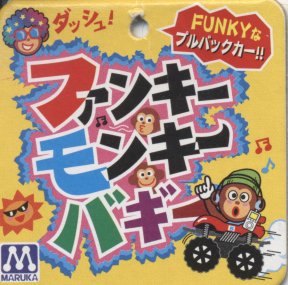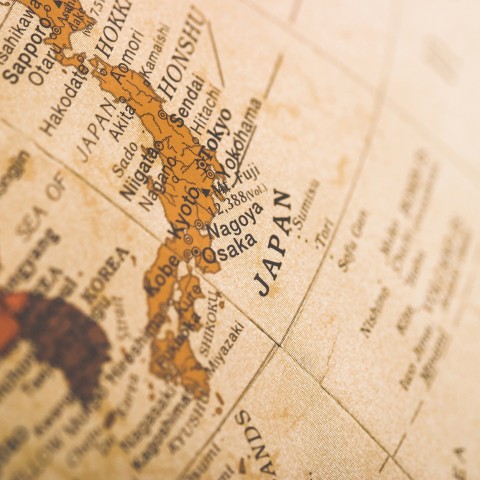- sci.lang.japan FAQ
- 5. Japanese and English
- Next: Where does the word yen come from?
 |
| Barber’s sign: English «thank you cut» has been transformed into «3 (san) Q» |
|---|
この内容を日本語で
Japanese usually writes words borrowed from foreign languages in
katakana. Katakana is phonetic, so a katakana transcription of an
English word is based on how the word sounds, not how it is
spelt. This page discusses ways to search for katakana versions of
English words, and the rules for katakana transcription.
The first place to look for a Japanese version of an English word is a
dictionary, to find the usual katakana equivalent. If the word is not
in the dictionary, try to find a Japanese person to help you. Other
tricks are explained in How can I find the Japanese name of a film, person, plant, etc.?
How a word appears as katakana depends on how the word is heard by
native speakers. Japanese has fewer different sounds than English, and
it does not have many ending consonants, so words tend to gain extra
vowels. For example, the English word «cat» becomes katakana
キャット (kyatto) with an extra «o» at the end, and «dog»
becomes ドッグ (doggu) with an extra «u» at the end.
Rules for conversion
Vowels and diphthongs are usually changed into the nearest
equivalent Japanese vowel. Japanese has fewer vowels than English, so
the two different vowels in «fur» and «far» both get turned into
Japanese ファー.
Plural words often become singular, thus «pajamas» becomes
pajama (パジャマ), and «slippers» becomes
suripaa (スリパー). Here the katakana パ used to
represent the first vowel of «pajamas» is based on the spelling of the
word.
Words with existing gairaigo forms usually keep that form. For
example, «black coffee» becomes burakku kōhii (ブラックコーヒー),
even though kōhii (コーヒー) for coffee originally comes from Dutch (see
Which Japanese words come from Dutch?).
Japanese has tended to favour British pronunciations, with words like
«vitamin», becoming a British-sounding bitamin (ビタミン)
rather than American-sounding baitamin (バイタミン). The vowels
used in Japanese are usually taken from the British pronunciation
rather than the American.
The following table outlines the rules for transcribing English
sounds. The English sounds are represented in International Phonetic
Alphabet (IPA) form.
| English sound (IPA) | Japanese | Examples | Japanese transcription Capitals indicate small kana |
|---|---|---|---|
| Short vowels | |||
| ɪ | イ, i | pit | ピット (pitto) |
| ɛ | エ, e | pet | ペット (petto) |
| æ | ア, a | ham | ハム (hamu) |
| æ after k | キャ, kya | cap | キャップ (kyappu) |
| ʌ | ア, a | mug | マグ (magu) |
| ʌ spelt with an «o» | オ, o (sometimes) | monkey, front, London | モンキー, フロント, ロンドン (monkii, furonto, rondon) |
| ɒ | オ, o | socks | ソックス (sokkusu) |
| ʊ | ウ, u | book | ブック (bukku) |
| Schwa (weak vowel) | |||
| non-final ə | not fixed, based on spelling. | about, pilot, London | アバウト, パイロット, ロンドン (abauto, pairotto, rondon) |
| final position ə | aa | carrier, hamburger | キャリアー, ハンバーガー (kyariā, hambāgā) |
| Long vowels | |||
| ɑː | アー, ア aa, a | car | カー (kā) |
| iː | イー: ii | shield | シールド (shiirudo) |
| ɔː | オー: oo | horse | ホース (hōsu) |
| oa | オア: door | ドア (doa) | |
| ɜː | アー: aa | bird | バード (bādo) |
| uː | ウー ū | shoe | シュー (shū) |
| juː | ュウ yū, see What is yōon? | cube | キューブ (kyūbu) |
| Diphthongs | |||
| eɪ | エイ, ei | day | デイ (dei) |
| aɪ | アイ, ai | my | マイ (mai) |
| ɔɪ | オーイ, ōi | boy | ボーイ (bōi) |
| オイ, oi | toy | トイ (toi) | |
| əʊ | オ, o | phone | フォン (fon) |
| オー, ō | no | ノー (nō) | |
| aʊ | アウ, au | now | ナウ (nau) |
| ɪə | イア, ia | pierce | ピアス (piasu) |
| ɛə | エア, ea | hair | ヘア (hea) |
| ʊə | ウアー, uaa | tour | ツアー (tsuā) |
| Consonants | |||
| θ | シャ, シ, シュ, シェ, ショ s | think | シンク (shinku) |
| ð | z | the | ザ (za) |
| r | ラ, リ, ル, レ, ロ: r-kana | right | ライト (raito) |
| l | ラ, リ, ル, レ, ロ: r-kana | link | リンク (rinku) |
| ŋ spelt «ng» | ンガ, ンギ ng | singer | シンガー (shingā) |
| ン, n (occasionally) | Washington, surfing | ワシントン, サーフィン (washinton, sāfin) | |
| ŋ spelt «nk» or «nc» | n | sink | シンク (shinku) |
| v | b | love | ラブ (rabu) |
| ヴァ, ヴィ, ヴ, ヴェ, ヴォ: v, written as ヴ (the u katakana) plus a small vowel | visual | ヴィジュアル (vijuaru) | |
| Consonants taking small vowel kana | |||
| w | ウィ: u + small vowel kana | win | ウィン (win) |
| f | ファ, フィ, フ, フェ, フォ: hu + small vowel kana | fight | ファイト (faito) |
| Special consonant and vowel combinations | |||
| ti, di | ティ, ディ (te or de + small i) (newer method) | Disney | ディズニー (dizunii) |
| chi, ji (older method) | |||
| tu | トゥ: to + small u (newer method) | Tourette’s syndrome | トゥレットシンドローム (turettoshindorōmu) |
| ツ: tsu | two | ツー (tsū) | |
| Consonant clusters | |||
| dz | ッズ zzu | goods, kids | グッズ, キッズ (guzzu, kizzu) |
Conversions based on spelling, and other oddities
 |
| Label from a children’s toy «funky monkey buggy» |
|---|
Although most of the conversion from an English word into Japanese is
based on the pronunciation, in several cases the pronunciation is
based on spelling. In particular the schwa sound, the «uh» at the end
of «doctor», has no near equivalent in Japanese and so is often
transcribed depending on the spelling of the vowel. Other cases where
spelling takes precedence include the ʌ vowel, the «u» in
«cup» and «hut», which is usually a, but when spelt with an o
becomes o. For example «monkey» is monkii rather than
mankii. Japanese also lengthens n sounds, such as
Anna (アンナ) for the English name Anna, when they are spelt
with two ns.
In some cases, a mis-reading of a word survives into Japanese. For
example, the woodworking tool «router», which should have become
rautā, is known as a rūtā, based on the
spelling.
Japanese tends to shorten three-mora constructions ending in
syllabic n (ん) into two moras. For example «stainless steel» becomes
sutenresu (ステンレス) rather than suteinresu (ステインレス).
Transcription of names
In the case of people’s names, Japanese tends to transcribe into
near-equivalent versions not based on the pronunciation. For example,
the English name Sarah is often transcribed into Sara (サラ)
rather than Sērā (セーラー). For example American politician
Sarah Palin is known as Sara Peirin (サラ・ペイリン) in
Japan. Naomi is transcribed into Naomi (ナオミ), a common
Japanese female name with a similar romanized spelling but different
pronunciation, rather than Nēomi, a much closer representation of
the pronunciation. For example British model Naomi Campbell is known
as Naomi Kyamberu (ナオミ・キャンベル) in Japan. Similarly,
Thomas is transcribed as Tōmasu using a long first vowel, and
even more extremely, Paul may be transcribed into Paoro.
- sci.lang.japan FAQ
- 5. Japanese and English
- Next: Where does the word yen come from?
Copyright © 1994-2022 Ben Bullock
If you have questions, corrections, or comments, please contact
Ben Bullock
or use the discussion forum / Privacy policy
|
|
|
|
|
|
|
Book reviews |
Convert |
Handwritten |
Stroke order |
Convert |

The Japanese language can be very difficult for English speakers to learn as these two languages are completely different in every aspect: origin, writing system, grammar, and phonetics. But when it comes to vocabulary, you may be surprised to hear that this isn’t really the case. There are actually quite a few English loanwords in Japanese!
There’s even a name for the mixing of these two languages: Japanglish.
Some of the English words used in Japanese have the same meaning as the original ones, while others have been localized and modified (often shortened), combined with Japanese words, and/or used with a completely different meaning.
In this article, we’ll introduce English words that are commonly used in Japanese. Although you may find some of them very weird, learning Japanglish is one of the easiest parts of learning Japanese and it will be helpful in your language studies.
There is a lot of Japanglish vocabulary used in Japan.
Table of Contents
- Introduction to Japanglish
- Typical English Loanwords in Japanese
- Japanglish Wasei Eigo
- How to Say These Names in Japanese
- English Words Borrowed From Japanese
- How JapanesePod101 Can Help You Learn More Japanese
1. Introduction to Japanglish
There are two types of English words used in the Japanese language: loanwords and Wasei-Eigo. Let’s take a closer look at each group.
Loanwords Used in Japanese
Loanwords, or 外来語 (gairai-go), are commonly used in modern Japanese. After two centuries of isolation, called 鎖国 (Sakoku), Japan became “open” to foreign countries in the mid-nineteenth century. This new status brought with it influences from Western cultures, and many of the first loanwords in Japan came from Portuguese, Dutch, French, and German. English loanwords started to gain prevalence during the post-World War II period. Since then, Japanglish has continued to evolve and grow in popularity.
While the younger Japanese generations often use loanwords without even realizing they’re originally from foreign languages, the older population hardly uses or understands them.
The most basic loanwords are English words used in Japanese with the same meaning, but with Japanese pronunciation. Examples include:
- カメラ (kamera) – “camera”
- タクシー (takushī) – “taxi”
- クリック (kurikku) – “click”
You have to keep in mind that loanwords are normally written with カタカナ (Katakana) letters and follow Japanese pronunciation rules. Also, when they’re written in alphabet form using ローマ字 (Roma-ji), or the romanization of Japanese, the spelling is often different from that of the original English words. This is because they’re transcribed according to how the Japanese read and pronounce words.
For example, all of the consonants in Japanese end with a vowel (あ a, い i, う u, え e, お o). In addition, since there’s no particular distinction between L and R in Japanese, all of the “L” sounds in English are expressed using “R” in Japanese. Thus, “click” is expressed as kurikku in Japanese.
To learn more about Japanese pronunciation, please see our “Japanese Pronunciation” article!
カタカナ (Katakana) characters are used to write loanwords.
Japanglish Wasei-Eigo: English Made in Japan
There are also English words used in Japanese that have been more fully integrated into the language. These are called 和製英語 (Wasei Eigo), or literally, “English made in Japan.”
Wasei Eigo refers to English words adopted into Japanese with unique meanings, word combinations, and/or abbreviations only used in Japan. Examples include:
- サラリーマン (sararīman)
- from “salaryman,” meaning “businessman who works at a company and gets a monthly salary”
- シャーペン (shāpen)
- short for “sharp pencil,” meaning “mechanical pencil”
サラリーマン (sararīman), or “salaryman” meaning “businessman,” is one of the most typical Japanglish words.
2. Typical English Loanwords in Japanese
These loanwords have the same meaning as their English counterparts and are commonly used in daily Japanese conversations.
| Loanword | Roma-ji / Reading | English Word |
| グラス | gurasu | glass |
| スプーン | supūn | spoon |
| フォーク | fōku | fork |
| ナイフ | naifu | knife |
| ビール | bīru | beer |
| ワイン | wain | wine |
| バス | basu | bus |
| バイク | baiku | (motor) bike |
| コンピューター | conpyūtā | computer |
| インターネット | intānetto | internet |
| ウェブサイト | webusaito | website |
| ホテル | hoteru | hotel |
| レストラン | resutoran | restaurant |
| テーブル | tēburu | table |
| サービス | sābisu | service |
| エレベーター | erebētā | elevator |
| ドア | doa | door |
| サイズ | saizu | size |
| シャツ | shatsu | shirt |
| ネクタイ | nekutai | necktie |
| サンダル | sandaru | sandal |
| サングラス | sangurasu | sunglasses |
| テスト | tesuto | test |
Words that are associated with Western-style restaurants are often used as loanwords in Japanese. These include レストラン (resutoran) – “restaurant” / ナイフ (naifu) – “knife” /ワイン (wain) – “wine.”
3. Japanglish Wasei Eigo
Learning Wasei-Eigo may be a bit more difficult, as these words and phrases have undergone alterations during their journey into the Japanese language. In this section, we’ll give you several Japanglish examples and explain them in more detail as needed.
English Words Used With Different Meanings
| Wasei Eigo | Roma-ji / Reading | English Word | Meaning |
| マンション | manshon | mansion | apartment (bigger building than アパート) |
| アパート | apāto | apart | apartment (smaller building than マンション) |
| コンセント | consento | consent | electrical outlet
Many Japanese people use the word “consent” to mean “electrical outlet.” It is said that it originates from the word “concentric plug.” |
| メイク | meiku | make | makeup |
| リンス | rinsu | rinse | hair conditioner |
| アイス | aisu | ice | ice cream |
| ホットケーキ | hotto kēki | hot cake | pancake |
| スーパー | sūpā | super | supermarket |
| レジ | reji | register | It originally comes from “cash register,” meaning “checkout counter” or “cashier.” |
| ファイト! | faito! | fight | This word is used to cheer someone up. It can mean “Hang in there,” “You can do it,” or “Do your best.” |
| ハイテンション | hai tenshon | high tension | very excited / hyper |
| テキスト | tekisuto | text | textbook / school manual |
| カンニング | kanningu | cunning | cheating on an exam |
| タレント | tarento | talent | television personality / entertainer |
Examples
- 次の試合は必ず勝つよ!ファイト!
Tsugi no shiai wa kanarazu katsu yo! Faito!
“You will definitely win the next match! Do your best!”
- 彼は昨日なぜかとてもハイテンションでした。
Kare wa kinō naze ka totemo hai tenshon deshita.
“He was very excited yesterday for some reason.”
- あなたの一番好きなタレントは誰ですか。
Anata no ichi-ban suki na tarento wa dare desu ka.
“Who is your most favorite TV personality?”
ホットケーキ (hotto kēki), or “hot cake,” means “pancake” in Japan.
Abbreviated Word Combinations
In Japanese, it’s common for two or more English words to be shortened into one word (usually with four syllables). Let’s see some examples.
| Wasei Eigo | Roma-ji / Reading | English Word | Meaning / Description |
| リモコン | rimokon | remote controller | remote controller
In Japanese, the first syllables from each word are combined. |
| マスコミ | masukomi | mass communication | mass communication / mass media / the press / journalism |
| エアコン/ クーラー | eakon / kūrā | air conditioner / cooler | air conditioner
クーラー (kūrā), or “cooler,” is also commonly used to mean “air conditioner.” |
| パソコン | pasokon | personal computer | computer
Along with コンピューター (conpyūtā), パソコン (pasokon) is also commonly used when talking about computers. |
| コンビニ | konbini | convenience store | This word refers to convenience stores that are open 24 hours a day and seen everywhere throughout Japan. |
| イメチェン | imechen | image change | This refers to changing one’s image, especially in terms of one’s hairstyle or clothing. |
| OL (オーエル) | ōeru | office lady | Similar to “salaryman,” this word refers to a woman who works at an office. This word is also an abbreviation. |
| CM (シーエム) | shīemu | commercial message | commercial
This abbreviation is used to mean “commercial” in Japanese. |
| BGM (ビージーエム) | bījīemu | background music | This refers to background music, especially when it’s played in a store, cafe, restaurant, etc. |
Examples
- 昨日私の古いパソコンが壊れました。
Kinō watashi no furui pasokon ga kowaremashita.
“Yesterday, my old computer broke.”
- イメチェンしたいなら髪型を変えるのが一番だよ!
Imechen shitai nara kamigata o kaeru no ga ichi-ban da yo!
“If you want to change your image, it’s best to change your hairstyle!”
- あのカフェのBGMはジャズがかかっていておしゃれです。
Ano kafe no bījīemu wa jazu ga kakatte ite oshare desu.
“That cafe plays jazz as background music and it’s fashionable.”
リモコン (rimokon) is an abbreviation of “remote controller.”
Words That Combine English and Japanese
Wasei Eigo can also get creative, with some words being a combination of an English loanword and a Japanese word.
| Wasei Eigo | Roma-ji / Reading | Composition of Words | Meaning |
| 省エネ | shōene | 省 (Kanji that represents “save”) + energy | energy-saving |
| 軽トラ | keitora | 軽 (Kanji that represents “light”) + truck | light (engine) truck / small truck |
| ガス欠 | gasuketsu | gas + 欠 (Kanji that represents “lack”) | running out of gasoline (petrol) |
| 懐メロ | natsumero | 懐 (Kanji that represents “nostalgic”) + melody | nostalgic song / all-time favorite song |
| ドタキャン | dotakyan | 土壇場 (dotanba), meaning “last moment” + cancellation | cancellation at the last moment |
| イタ飯 | itameshi | Italian + 飯 (meal/food) | Italian food |
| 猛ダッシュ | mōdasshu | 猛 (Kanji that represents “fierce” / “intense” / “acute”) + dash | sprint / run as fast as one can |
Examples
- 新しい冷蔵庫は省エネモデルです。
Atarashii reizōko wa shōene moderu desu.
“The new refrigerator is an energy-saving model.”
- ガス欠により道の真ん中で車が止まった。
Gasuketsu ni yori michi no mannaka de kuruma ga tomatta.
“The car stopped in the middle of a road due to running out of gasoline.”
- まりこはいつもデートをドタキャンする。
Mariko wa itsumo dēto o dotakyan suru.
“Mariko always cancels a date at the last moment.”
Loanwords Turned Into Japanese Verbs
By adding the Japanese word する (suru), or “to do,” after a loanword (whether it’s a noun or a verb), it becomes a verb in Japanese.
| Wasei Eigo | Roma-ji / Reading | Composition of Words | Meaning |
| ドライブする | doraibu suru | drive + suru | to go for a drive |
| ノックする | nokku suru | knock + suru | to knock |
| キャンセルする | kyanseru suru | cancel + suru | to cancel |
| ジョギングする | jogingu suru | jogging + suru | to jog |
| リラックスする | rirakkusu suru | relax + suru | to relax |
| ジャンプする | janpu suru | jump + suru | to jump |
| キスする | kisu suru | kiss + suru | to kiss |
| メイクする | meiku suru | make + suru | to put on makeup |
| パーティーをする | pātī o suru | party + o + suru | to party |
| ギャンブルする | gyanburu suru | gamble + suru | to gamble |
Examples
- 私はお風呂に入ってリラックスするのが好きです。
Watashi wa o-furo ni haitte rirakkusu suru no ga suki desu.
“I like to take a bath and relax.”
- 私たちは週末に誕生日パーティーをする予定です。
Watashi-tachi wa shūmastu ni tanjōbi pātī o suru yotei desu.
“We plan to have a birthday party over the weekend.”
- 入る前にドアをノックしてください。
Hairu mae ni doa o nokku shite kudasai.
“Please knock on the door before entering.”
To learn all about conjugation in Japanese, please see our article on Japanese Verb Conjugations.
パーティーをする (pātī o suru) – “to party”
4. How to Say These Names in Japanese
In Japan, world-famous brand names are pronounced according to Japanese pronunciation rules and are sometimes called something different. Here are a few examples.
- Google: グーグル (Gūguru)
- Apple: アップル (Appuru)
- Starbucks: スターバックス (Sutābakkusu)
A shortened version, スタバ (Sutaba), is commonly used in daily conversations.
- Kentucky Fried Chicken: ケンタッキー フライド チキン (Kentakkī furaido chikin)
There are also a couple of shortened versions often used in daily conversations: ケンタッキー (Kentakkī) and ケンタ (Kenta).
- McDonald’s: マクドナルド (Makudonarudo)
Depending on the region of Japan, there are different shortened versions for this brand name.
- ➢ Kanto (Tokyo, Chiba, Saitama, Kanagawa) and other regions: マック (Makku)
➢ Kansai region (around Osaka, Kyoto, Nara, Hyogo, etc.): マクド (Makudo)
There are even different dialect forms for “McDonald’s” in Japanese!
5. English Words Borrowed From Japanese
Due to globalization, there are also plenty of popular Japanese words in English! Let’s look at a few of these borrowed words:
| Food-Related Words | Kanji / Hiragana | Meaning / Description |
| Sushi | 寿司 / すし | Sushi is a famous Japanese food, consisting of vinegared rice and raw and/or cooked seafood. |
| Teriyaki | 照り焼き / てりやき | Teriyaki is a Japanese cooking technique and flavor. Foods are broiled or grilled with a glaze of sauce made of soy sauce, mirin, and sugar. 照り(teri) refers to a shine/luster and 焼き (yaki) means “grill.” |
| Tofu | 豆腐 / とうふ | Tofu is bean curd made of soybeans. The Japanese word Tofu originates from the Chinese word 豆腐 (dòufu), which literally means 豆 (“bean”) + 腐(“curdled” or “fermented”). |
| Edamame | 枝豆 / えだまめ | Edamame is a dish of immature soybeans, usually boiled and salted. |
| Sake | 酒 / さけ | Sake literally means “alcoholic drink” in Japanese, but it often refers to Japanese rice wine, or 日本酒 (Nihonshu). |
| Matcha | 抹茶 / まっちゃ | Matcha refers to green tea leaves that have been finely ground into a powder. Green tea leaves for Matcha are grown and processed using a specific method. |
| Bento | 弁当 / べんとう | Bento is a reusable lunch box that can contain a single-portion meal, usually consisting of rice and some sides. |
| Culture-Related Words | Kanji / Hiragana | Meaning / Description |
| Bonsai | 盆栽 / ぼんさい | Bonsai is an artform of planting that uses cultivation techniques to produce small trees in containers. Bonsai literally means “tray planting.” |
| Origami | 折り紙 / おりがみ | Origami is the art of folding papers, usually done with square papers that have color on one side and white on the other side. Origami breaks down as:
折り(ori) – “fold” + 紙 (kami/gami) – “paper” |
| Emoji | 絵文字 / えもじ | Emoji is a type of pictograph that is used in electronic messages, originally invented in Japan. Emoji breaks down as:
絵 (e) – “picture” + 文字 (moji) – “character” |
| Manga | 漫画 / まんが | Manga refers to Japanese-style comics that are often animated. |
| Cosplay (Kosupure) | コスプレ | The word コスプレ (Kosupure) comes from “costume play.” It is a type of performance art in which participants (cosplayers) dress up as characters from their favorite manga or anime. |
| Karaoke | カラオケ | Karaoke is a shortened version of 空 (kara), meaning “empty,” and オーケストラ (ōkesutora), meaning “orchestra.”
It is a form of entertainment where an amature sings popular songs using a microphone, following along with the instrumental music/melody and lyrics displayed on a video screen. |
| Sudoku | 数独 / すうどく | Sudoku is a logic-based number-placement puzzle. The word 数独 (Sudoku) is an abbreviation that means “number” + “single,” coming from the rule of this puzzle: “the digits must be single” or “the digits are limited to one occurrence.” |
| Other Famous Words | Kanji / Hiragana | Meaning / Description |
| Kaizen | 改善 / かいぜん | 改善 (Kaizen) is literally translated as “improvement.” Kaizen in English often refers to “continuous improvement” in business atmospheres. It became known as the Japanese way of doing business to optimize processes and produce better results. |
| Karoshi | 過労死 / かろうし | 過労死 (Karoshi) literally means “death of overwork.” It refers to death as the result of mental and/or physical illness from working too much or being under too much pressure. |
| Tsunami | 津波 / つなみ | 津波 (Tsunami) literally means “port wave.” It is a series of huge waves, usually in an ocean. A Tsunami can be caused by earthquakes, volcanic eruptions, and other underwater explosions. |
| Typhoon | 台風 / たいふう | A Typhoon is a huge tropical cyclone that can be seen in the Northern Hemisphere, in the region called the Northwestern Pacific Basin. The Japanese word 台風 (taifū) became the English “typhoon.” |
Tsunami (津波) is one of the most famous Japanese words that was adapted into English.
How JapanesePod101 Can Help You Learn More Japanese
In this article, we introduced English words used in Japanese. We covered the history of loanwords in Japan and how Japanglish developed, basic loanwords from English and various types of Wasei Eigo, as well as famous Japanese words in English. While some Japanglish terms sound funny and weird, they are definitely helpful to learn and can help you understand Japanese better!
Did you learn anything new about Japanese today? Are there any important words or terms you know about that we didn’t include? Let us, and your fellow language learners, know in the comments!
If you would like to learn more about the Japanese language and culture, you’ll find a lot more helpful content on JapanesePod101.com. We provide a variety of free lessons to help you improve your Japanese language skills. For example, you can view the following vocabulary lists to learn the very basics of Japanese:
- 100 Most Common Nouns
- 50 Most Common Verbs
- 50 Most Common Adjectives
You can also take advantage of our personal one-on-one coaching service, MyTeacher, when you subscribe to a Premium PLUS membership. Your private teacher will help you practice pronunciation and give you personalized feedback and advice to help you improve efficiently.
And there is so much more we have to offer you! Learn Japanese faster and enjoy studying with JapanesePod101.com!

Words of Japanese origin have entered many languages. Some words are simple transliterations of Japanese language words for concepts inherent to Japanese culture, but some are actually words of Chinese origin that were first exposed to English via Japan. The words on this page are an incomplete list of words which are listed in major English dictionaries and whose etymologies include Japanese. The reverse of this list can be found at List of gairaigo and wasei-eigo terms.
ArtsEdit
- anime
- アニメ listen (help·info), hand-drawn and computer animation originating from or associated with Japan.
- bokeh
- (from ぼけ boke), subjective aesthetic quality of out-of-focus areas of an image projected by a camera lens.
- bonsai
- 盆栽 listen (help·info), «tray gardening»; the art of tending miniature trees. Originated from Chinese 盆栽 penzai
- bunraku
- [1] 文楽, a form of traditional Japanese puppet theatre, performed by puppeteers, chanters, and shamisen players.
- haiku
- 俳句 listen (help·info), a very short poem consisting of three lines of 5, 7, and 5 morae (not syllables as commonly thought) each; see also tanka below.
- ikebana
- 生花, flower arrangement.
- imari
- [2] 伊万里, Japanese porcelain wares (made in the town of Arita and exported from the port of Imari, particularly around the 17th century).
- kabuki
- [3] 歌舞伎, a traditional form of Japanese theatre; also any form of elaborate theatre, especially metaphorically.[4]
- kaiju
- 怪獣, Japanese genre of horror and science fiction films featuring giant monsters.
- kakemono
- [5] 掛け物, a vertical Japanese scroll, of ink-and-brush painting or calligraphy, that hangs in a recess on a wall inside a room.
- kakiemon
- [6] 柿右衛門, Japanese porcelain wares featuring enamel decoration (made in Arita, using the style developed in the 17th century by 酒井田 柿右衛門 Sakaida Kakiemon).
- karaoke
- カラオケ listen (help·info), (English IPA : [kæriːoʊkiː]) «empty orchestra»; entertainment where an amateur singer accompanies recorded music.
- kirigami
- 切り紙, similar to origami, but involves cutting in addition to folding.
- koto
- [7] 琴, a traditional stringed musical instrument from Japan, resembling a zither with 13 strings.
- makimono
- [8] 巻物, a horizontal Japanese hand scroll, of ink-and-brush painting or calligraphy
- manga
- まんが or 漫画 listen (help·info), (English IPA : [mæŋgɜː]) Japanese comics; refers to comics in general in Japanese
- netsuke
- [9] 根付, a toggle used to tie the sash of a kimono also to attach small items such as inro and kinchaku: sometimes beautifully carved.
- noh
- [10] 能 nō, a major form of classical Japanese music drama
- origami
- 折り紙, artistic paper folding. (British English IPA : [ɒrɪgɑːmiː])
- otaku
- オタク or おたく or ヲタク, a geeky enthusiast, especially of anime and manga.
- senryu
- 川柳, a form of short poetry similar to haiku.
- shamisen
- [11] 三味線, a three-stringed musical instrument, played with a plectrum.
- sumi-e
- 墨絵, a general term for painting with a brush and black ink.
- tanka
- 短歌, «short poetry»; an older form of Japanese poetry than haiku, of the form 5-7-5-7-7 morae (not syllables; see also haiku above).
- tankōbon
- 単行本, «independent/standalone book»; term for a book that is complete in itself and is not part of a series or corpus. In modern Japan, though, it is most often used in reference to individual volumes of a single manga, as opposed to magazines.
- ukiyo-e
- 浮世絵, a type of woodblock print art or painting. (English IPA : [uːkiːoʊ.iː])
- waka
- 和歌, «Japanese poetry»; a word used primarily to describe tanka (see above) written between the 9th and 19th centuries.
- wabi-sabi
- 侘び寂び, a world view or aesthetic centered on the acceptance of transience and imperfection.
BusinessEdit
- kaizen
- [12] 改善, literally «change for the better.» In practice, a Japanese business philosophy of continuous improvement of working practices, personal efficiency, etc. Initially made famous by the 1986 book of same name.
- kanban
- [13] 看板, literally a «signal» or «sign» signals a cycle of replenishment for production and materials and maintains an orderly and efficient flow of materials throughout the entire manufacturing process.
- karoshi
- 過労死, «death by overwork, stress death»
- keiretsu
- 系列, a set of companies with interlocking business relationships and shareholdings.
- Poka-yoke
- «mistake-proofing» or «inadvertent error prevention».
- tycoon
- 大君 («taikun»), «great prince» or «high commander», later applied to wealthy business leaders.
- zaibatsu
- 財閥, a «money clique» or conglomerate
ClothingEdit
- geta
- [14] 下駄, a pair of Japanese raised wooden clogs worn with traditional Japanese garments, such as the kimono
- inro
- [15] 印籠 inrō, a case for holding small objects, often worn hanging from the obi; (traditional Japanese clothes didn’t have pockets)
- kimono
- 着物, a traditional full-length robe-like garment still worn by women, men and children. (English IPA : [kɪmoʊnoʊ])
- obi
- [16] 帯, a wide belt that is tied in the back to secure a kimono
- yukata
- 浴衣, a casual or simplified summer style of kimono
- zori
- [17] 草履 zōri, sandals made from rice straw or lacquered wood, worn with a kimono for formal occasions
CulinaryEdit
- adzuki,[18] azuki bean
- [19] あずき or 小豆 listen (help·info), type of bean grown in eastern Asia and the Himalayas, used in Chinese, Korean, and Japanese cuisines, usually served sweet
- arame
- 荒布, a type of edible seaweed
- bento
- 弁当 bentō, a single-portion takeout meal, box lunch
- daikon
- 大根, a kind of white radish
- dashi
- だし or 出汁, a simple soup stock considered fundamental to Japanese cooking
- edamame
- 枝豆, soybeans boiled whole in the green pod and served with salt
- enokitake, enoki mushroom
- えのきたけ or 榎茸, long, thin white mushrooms, used in Japanese, Korean and Chinese cuisines
- fugu
- 河豚 or フグ, the meat of the toxic pufferfish, must be prepared by specially trained chefs by law. Also means pufferfish itself.
- ginkgo
- 銀杏 or ぎんなん ginnan, a gymnospermous tree (Ginkgo biloba) of eastern China that is widely grown as an ornamental or shade tree and has fan-shaped leaves and yellow fruit (the word is derived from 17th Century Japanese 銀杏 ginkyō)
- gyoza
- ギョーザ or 餃子 gyōza, Japanese name for Chinese dumplings, jiaozi (jiǎozi); may also be called pot stickers in English if they are fried
- hibachi
- 火鉢, a small, portable charcoal grill; used in North America to refer to a teppan or a small shichirin-like aluminium or cast iron grill
- hijiki
- ひじき or 鹿尾菜, a type of edible seaweed commonly found on rocky coastlines
- katsu
- カツ, Japanese term for cutlets in general; in English, typically refers to the dish chicken katsu, a type of breaded chicken cutlet served with rice and sauce.[20] (English IPA : [kæt.suː])
- katsuo
- 鰹, a skipjack tuna
- katsuobushi
- かつおぶし or 鰹節, dried and smoked skipjack tuna (katsuo), which is shaved and then used in dashi
- koji
- 麴 or 麹 kōji, a fungus that is the active agent in the fermentation processes, of producing miso and soy sauce from soybeans, and of producing sake and shōchū from rice.
- kombu
- 昆布, dried kelp, which can be eaten or used as dashi
- matsutake
- 松茸, a type of edible mushroom, with a magnificently spicy aroma similar to cinnamon, considered to be a great delicacy and the most coveted mushroom in Japan
- mirin
- 味醂, an essential condiment of the Japanese cuisine, a kind of rice wine similar to sake with a slightly sweet taste
- miso
- 味噌, a thick paste made by fermenting soybeans with salt
- mizuna
- 水菜, an edible plant, with flavor akin to the mustard plant
- mochi
- 餅, sticky rice cake
- napa cabbage
- 菜っ葉, Chinese cabbage, (in Japan, it is a generic term for leaf vegetables.)
- nashi (pear)
- 梨, a species of pear native to eastern Asia, which are juicy, round and shaped like apples. Often simply referred to as «asian pear(s)».
- natto
- 納豆, traditional Japanese food made from fermented soybeans
- nori
- 海苔, food products created from the seaweed laver by a shredding and rack-drying process that resembles papermaking.
- panko
- パン粉, Japanese white bread flakes. Panko is made from bread without crusts, thus it has a crisper, airier texture than most types of breading found in Western cuisine.
- ramen
- ラーメン rāmen, the Japanese version of Chinese noodle soup, not limited to the instant variety. (British English IPA : [rɑːmen])
- sake
- 酒 listen (help·info),nihon-shu(日本酒), an alcoholic beverage, brewed from rice. In Japanese, the word commonly refers to alcoholic drinks in general
- sashimi
- 刺身, a Japanese delicacy primarily consisting of the freshest raw seafoods thinly sliced and served with only a dipping sauce and wasabi.
- satsuma
- (from 薩摩 Satsuma, an ancient province of Japan), a type of mandarin orange (mikan) native to Japan
- shabu shabu
- しゃぶしゃぶ, a meal where each person cooks their own food in their own cooking pot from an assortment of raw ingredients
- shiitake mushroom
- しいたけ or 椎茸 listen (help·info), an edible mushroom typically cultivated on the shii tree
- shoyu
- 醬油 or 醤油shōyu, Japanese soy sauce
- soba
- 蕎麦 or ソバ, thin brown buckwheat noodles
- soy
- from shoyu 醤油
- sukiyaki
- すき焼き or スキヤキ, a dish in the nabemono-style (one-pot), consisting of thinly sliced beef, tofu, konnyaku noodles, negi, Chinese cabbage (bok choy), and enoki mushrooms among others
- surimi
- すり身 or 擂り身, processed meat made from cheaper white-fleshed fish, to imitate the look of a more expensive meat such as crab legs
- sushi
- 鮨 or 鮓 or 寿司, a dish consisting of vinegared rice combined with other ingredients such as raw fish, raw or cooked shellfish, or vegetables
- takoyaki
- たこ焼, たこ焼き, or 章魚焼き, literally fried or baked octopus
- tamari
- 溜まり or たまり, liquid obtained by pressing soybeans
- tempura
- てんぷら or 天麩羅, classic Japanese deep fried batter-dipped seafood and vegetables. The word may be from Portuguese tempêro/seasoning.[21]
- teppanyaki
- 鉄板焼き, a type of Japanese cuisine that uses a hot iron griddle (teppan) to cook food
- teriyaki
- 照り焼き or テリヤキ, a cooking technique where fish or meat is being broiled/grilled in a sweet soy sauce marinade; in Japanese, it is used exclusively refer to poultry cooked in this manner.
- tofu
- 豆腐 tōfu listen (help·info) bean curd. Although the word is originally Chinese, it entered English via Japanese.
- udo
- ウド or 独活, an edible plant found on the slopes of wooded embankments, also known as the Japanese Spikenard
- udon
- うどん or 饂飩, a type of thick wheat-based noodle
- umami
- 旨味 or うま味, the taste sensation produced by some condiments such as monosodium glutamate; a basic flavor in sea weed (昆布 kombu)
- umeboshi
- 梅干, pickled ume
- wakame
- ワカメ or 若布, a type of edible kelp, often used in miso soup (Japan), and salads
- wasabi
- わさび or 山葵, a strongly flavoured green condiment also known as Japanese horseradish
- yakitori
- 焼き鳥 or 焼鳥, a type of chicken kebab.
Government and politicsEdit
- daimyō
- [22] 大名 daimyō, «great names»; the most powerful Japanese feudal rulers from the 12th century to the 19th century
- genro
- [23] 元老 genrō, retired elder Japanese statesmen, who served as informal advisors to the emperor, during the Meiji and Taisho eras
- mikado
- [24] 帝, a dated term for «emperor»; specifically for the Emperor of Japan
- shogun
- [25] 将軍 shōgun listen (help·info), the title of the practical ruler of Japan for most of the time from 1192 to the Meiji Era
- tenno
- [26] 天皇, a term for the Emperor of Japan
Martial artsEdit
- aikido
- [27] 合気道 aikidō
- dojo
- 道場 dōjō
- judo
- [28] 柔道 jūdō, refers to the Olympic sport.
- jujutsu
- [29] 柔術 jūjutsu, alternately spelt, through mutation, as jiu-jitsu in English.
- karate
- [30] 空手 a fighting style which includes the use of hands and feet to strike the opponent, without any weapon, and is also a popular international sports event. Literally means «empty handed».
- kendo
- [31] 剣道 kendō
- sumo
- [32] 相撲 sumō
ReligionEdit
- bonze
- [33] (from 凡僧 bonsō), a Buddhist monk
- koan
- [34] 公案 kōan, a paradoxical story or statement used during meditation in Zen Buddhism. Inspired the hacker koan tradition among computing circles.
- satori
- [35] 悟り, enlightenment in Zen Buddhism
- shinto
- [36] 神道 shintō, the native religion of Japan
- torii
- [37] 鳥居, traditional Japanese gates commonly found at the gateway to Shinto shrines
- zen
- 禅, from Chinese 禪 (Mandarin Chán), originally from ध्यान Sanskrit Dhyāna / Pali झान Jhāna, a branch of Mahāyāna Buddhism.
OtherEdit
- ahegao
- アヘ顔, a facial expression in pornographic animation and manga usually depicted when someone is having an orgasm
- akita
- 秋田 (from 秋田犬, akitainu or akitaken), the Akita Inu, a large breed of Japanese dog
- baka
- (馬鹿, ばか in hiragana, or バカ in katakana) means «fool», «silly», «stupid», or «foolish» and is the most frequently used pejorative term in the Japanese language.[citation needed]
- bukkake
- ぶっかけ, a sex act portrayed in pornographic films, in which several men ejaculate on a woman, or another man. Note that in Japanese it has a broader meaning of «to pour» or «to splash».
- domoic acid
- (from ドウモイ doumoi in the Tokunoshima dialect of Japanese: a type of red algae)
- emoji
- 絵文字, ideograms used in electronic messages and webpages.
- futon
- (from 布団, a flat mattress with a fabric exterior stuffed with cotton, wool, or synthetic batting that makes up a Japanese bed.)
- gaijin
- 外人, lit. outsider/alien is a Japanese word for foreigners and non-Japanese. The word is typically used to refer to foreigners of non-Asian ethnicities.
- geisha
- 芸者, traditional Japanese artist-entertainers
- hentai
- 変態 listen (help·info), Western usage: pornographic Anime, usually either Japanese in origin or drawn in a Japanese style; Japanese usage: metamorphosis, transformation, abnormality, or perversion
- hikikomori
- ひきこもり or 引き籠もり, a psychological condition where the affected individual lives an extremely socially isolated lifestyle, a decision of preference not by default, (compare NEET)
Look up hancho or honcho in Wiktionary, the free dictionary.
- honcho
- [38] 班長 hanchō, head, chief
- kamikaze
- [39] 神風, the literal meaning is «divine wind»; used to refer to a Japanese soldier in World War II who crashed an airplane into a target, committing suicide; also refers to the airplane used in the suicide crash
- katana
- (from かたな literally sword) A Japanese sword that has been forged using traditional Japanese methods. This is referred to as 日本刀 (nihontō) in Japanese.
- katsura (tree)
- 桂, large deciduous trees, native to eastern Asia
- kawaii
- 可愛い, cute and/or lovely. (English IPA ː [kəwaɪ])
- koi
- 鯉, Western usage: ornamental varieties of the common carp (but in Japan this just means «carp» – the ornamental variety are called «nishikigoi» 錦鯉)
- kudzu
- (from 葛 or クズ kuzu) A climbing vine found as an invasive species in the south-eastern US, which is native to Japan and south-eastern China
- moxa
- もぐさ or 艾 mogusa, mugwort or cotton wool or other combustible material, burned on skin during moxibustion
- moxibustion
- (from moxa + (com)bustion), an oriental medicine therapy which involves the burning of moxa (see above)
- ninja
- Japanese covert agent of the feudal era
- rickshaw
- (from 人力車 jinrikisha/ninryokusha), a human-pulled wagon
- sayonara
- 左様なら or さようなら sayōnara the Japanese term for «goodbye»
- samurai
- 侍 or 士, Japanese knight
- sensei
- 先生, the Japanese term for «master», «teacher» or «doctor». It can be used to refer to any authority figure, such as a schoolteacher, professor, priest, or politician.
- senpai
- 先輩, the Japanese term for «upperclassman» or «senior».
- shiatsu
- 指圧, a form of massage
- shiba inu
- 柴犬, the smallest of the six original and distinct Japanese breeds of dog
- shinro
- しんろ, a logic puzzle related to sudoku
- skosh
- [40] A small amount, from 少し or すこし sukoshi, meaning «a bit» or «a few»
- sudoku
- 数独 sūdoku listen (help·info), a number placement puzzle, also known as Number Place in the United States.
- tanuki
- 狸, the Japanese name for the animal, Nyctereutes procyonoides, known as a Japanese raccoon dog in English
- tsunami
- 津波, literally «harbor wave»; Large wave caused by earthquakes or other underwater disturbances. (English IPA ː [(t)suːnɑːmiː])
- tsuresari
- 連れ去り, abducting or kidnapping a child by the parent while defying the rights of the other parent.
- urushiol
- (from 漆 or うるし urushi, a plant that gives a skin rash on contact) a chemical substance found in poison-ivy, used to make lacquer-ware
ReferencesEdit
- ^ Merriam-Webster Online Dictionary (Retrieved on April 16, 2009)
- ^ Merriam-Webster Online Dictionary (Retrieved on April 16, 2009)
- ^ Merriam-Webster Online Dictionary (Retrieved on April 16, 2009)
- ^ «It’s time for pundits to stop using the word «kabuki.»«. 14 April 2010.
- ^ Merriam-Webster Online Dictionary (Retrieved on April 16, 2009)
- ^ Merriam-Webster Online Dictionary (Retrieved on April 16, 2009)
- ^ Merriam-Webster Online Dictionary (Retrieved on April 16, 2009)
- ^ Merriam-Webster Online Dictionary (Retrieved on April 16, 2009)
- ^ Merriam-Webster Online Dictionary (Retrieved on April 16, 2009)
- ^ Merriam-Webster Online Dictionary (Retrieved on April 16, 2009)
- ^ Merriam-Webster Online Dictionary (Retrieved on April 16, 2009)
- ^ [1] (Retrieved on October 21, 2013)
- ^ Merriam-Webster Online Dictionary (Retrieved on April 16, 2009)
- ^ Merriam-Webster Online Dictionary (Retrieved on April 16, 2009)
- ^ Merriam-Webster Online Dictionary (Retrieved on April 16, 2009)
- ^ Merriam-Webster Online Dictionary (Retrieved on April 16, 2009)
- ^ Merriam-Webster Online Dictionary (Retrieved on April 16, 2009)
- ^ Merriam-Webster Online Dictionary (Retrieved on April 16, 2009)
- ^ Merriam-Webster Online Dictionary (Retrieved on April 16, 2009)
- ^ «Chicken katsu curry». The Independent. Retrieved 2020-01-23.
- ^ «Home : Oxford English Dictionary».
- ^ Merriam-Webster Online Dictionary (Retrieved on April 16, 2009)
- ^ Merriam-Webster Online Dictionary (Retrieved on April 16, 2009)
- ^ Merriam-Webster Online Dictionary (Retrieved on April 16, 2009)
- ^ Merriam-Webster Online Dictionary (Retrieved on April 16, 2009)
- ^ Merriam-Webster Online Dictionary (Retrieved on April 16, 2009)
- ^ Merriam-Webster Online Dictionary (Retrieved on March 19, 2010)
- ^ Merriam-Webster Online Dictionary (Retrieved on March 19, 2010)
- ^ Merriam-Webster Online Dictionary (Retrieved on March 19, 2010)
- ^ Merriam-Webster Online Dictionary (Retrieved on March 19, 2010)
- ^ Merriam-Webster Online Dictionary (Retrieved on March 19, 2010)
- ^ Merriam-Webster Online Dictionary (Retrieved on March 19, 2010)
- ^ Merriam-Webster Online Dictionary (Retrieved on April 16, 2009)
- ^ Merriam-Webster Online Dictionary (Retrieved on April 16, 2009)
- ^ Merriam-Webster Online Dictionary (Retrieved on April 16, 2009)
- ^ Merriam-Webster Online Dictionary (Retrieved on April 16, 2009)
- ^ Merriam-Webster Online Dictionary (Retrieved on April 16, 2009)
- ^ Merriam-Webster Online Dictionary (Retrieved on April 30, 2009)
- ^ Merriam-Webster Online Dictionary (Retrieved on October 7, 2011)
- ^ Merriam-Webster Online Dictionary (Retrieved on July 21, 2009)
See alsoEdit
- Glossary of anime and manga
- Japanese words of English origin
- Cuisine of Japan
- Category:Japanese food preparation utensils
- Etiquette in Japan
- Japanese honorifics
- Aizuchi
- Japanese pronouns
When Japanese doesn’t have its own word for something it can use one of its two phonetic alphabets to represent a word from another language.
computer konpyu-ta コンピュータ
But as Japanese has a limited range of sounds, some loanwords (such as those with a “v” or “w” sound) don’t bear much resemblance to the original.
Other loanwords are tricky to revert back into their original language as the Japanese phonetic alphabets do not distinguish between certain sounds (such as “l” and “r”).
Not all loanwords come from English.
アルバイト arubaito arbeit (German “to work”), “a part time job”
And sometimes, the loanword has parted ways with the meaning of the original word.
コンデンサー kondensa- capacitor (not “condenser”)
So although the phonetic alphabets can reveal the identity of a foreign word, they can also conceal it.
English words of Japanese origin
|
|














